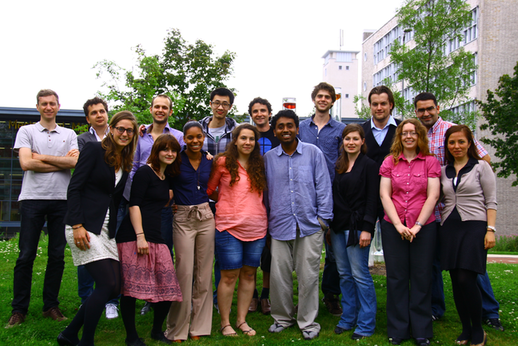Team:TU-Delft
From 2012.igem.org
(Difference between revisions)
| Line 17: | Line 17: | ||
<body> | <body> | ||
| - | + | <div style="height:70px; width:100%;"></div> | |
<img src="https://static.igem.org/mediawiki/igem.org/7/74/Background_greenlamp.jpg" class="bg_team"> | <img src="https://static.igem.org/mediawiki/igem.org/7/74/Background_greenlamp.jpg" class="bg_team"> | ||
| Line 77: | Line 77: | ||
<h3home>Snifferomyces</h3home> | <h3home>Snifferomyces</h3home> | ||
| - | + | <font size="2">Snifferomyces is a modular system, used in the detection of volatile compounds. It has in the membrane a <b>G-protein–coupled receptor</b> that can bind to a <b>specific signal</b>, once bound it then <b>switches on a signaling machinery</b> which <b>transmits</b> this <b>information</b> over the plasma membrane and through the cell to <b>produce a Quantitative response</b> in the form of <a href="https://2012.igem.org/Team:TU-Delft/part2"><b>fluorescence</b></a>. Using the Snifferomyces, our <b>aim</b> is to develop a <b>universal olfactory system</b> which <b>allows scientists</b> to <a href="https://2012.igem.org/Team:TU-Delft/part1#A3"><b>introduce olfactory</a> receptors in yeast with minimal effort.</b> | |
<b>G-protein–coupled receptors (GPCRs)</b> are one of the most important classes of proteins in living organisms that allows <b>transmission of a wide variety of signals</b> over the cell membrane, between cells and over long distances in the human body, thus acting as both the <b>gatekeepers</b> and <b>molecular messengers</b> of the cell. The importance of these receptors is emphasized by the <b>Nobel prize</b> awarded in 2004 for the discoveries of <b>"odorant receptors and the organization of the olfactory system"</b> and in 2012 for <b>"studies of G-protein–coupled receptors".</b></p> | <b>G-protein–coupled receptors (GPCRs)</b> are one of the most important classes of proteins in living organisms that allows <b>transmission of a wide variety of signals</b> over the cell membrane, between cells and over long distances in the human body, thus acting as both the <b>gatekeepers</b> and <b>molecular messengers</b> of the cell. The importance of these receptors is emphasized by the <b>Nobel prize</b> awarded in 2004 for the discoveries of <b>"odorant receptors and the organization of the olfactory system"</b> and in 2012 for <b>"studies of G-protein–coupled receptors".</b></p> | ||
| - | </font | + | </font> |
<br/> | <br/> | ||
Revision as of 15:12, 26 October 2012



|

|

|

|


- Localization of receptor NR1 using FLAG
- Activation of receptor NR1 by the ligand niacin
- Activation of the reporter by the native ligand alpha pheromone
- Providing a platform to swap receptors, promoters and terminators more easy
- Device design for yeast olfactory detector
- Deterministic and stochastic simulations and property analyses of pathway model
- Data fitting for deterministic pathway model
- Prediction of a ligand-binding niche within the human niacin receptor 1 with Molecular Dynamics simulations
- To find stake holders and create awareness among our project, we presented our project to a very large audience by participating in several events like Llowlab on Lowlands and the Floriade.
- Our main goal is to innovate a diagnostic tool for tuberculosis, one of the major health issues in the world
- We have provided the iGEM Paris 2012 team two Biobricks. Together with the Amsterdam team we were able to organize a crash course on the area of synthetic biology and we were honored to attend the LIFE-symposium with the Cambrigde 2010-team.
 "
"














